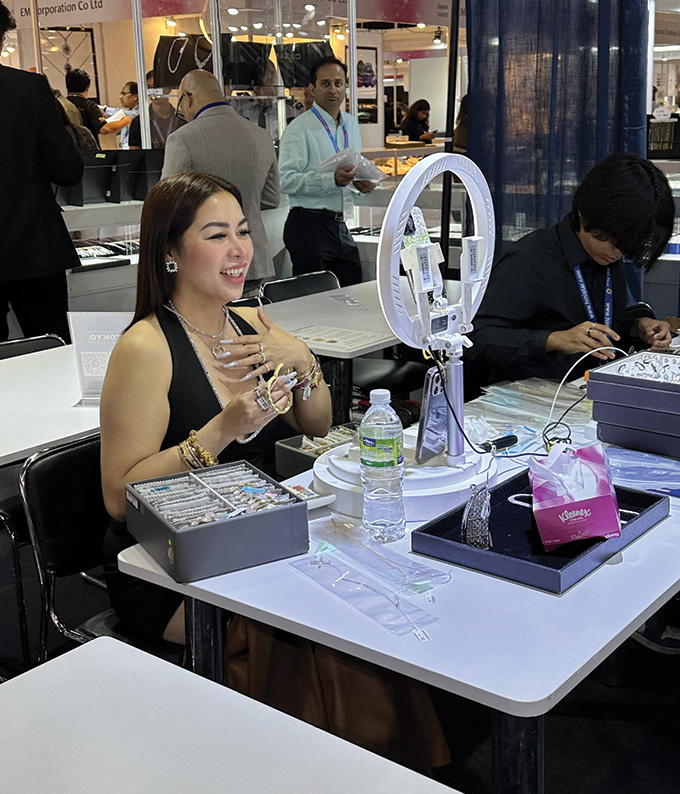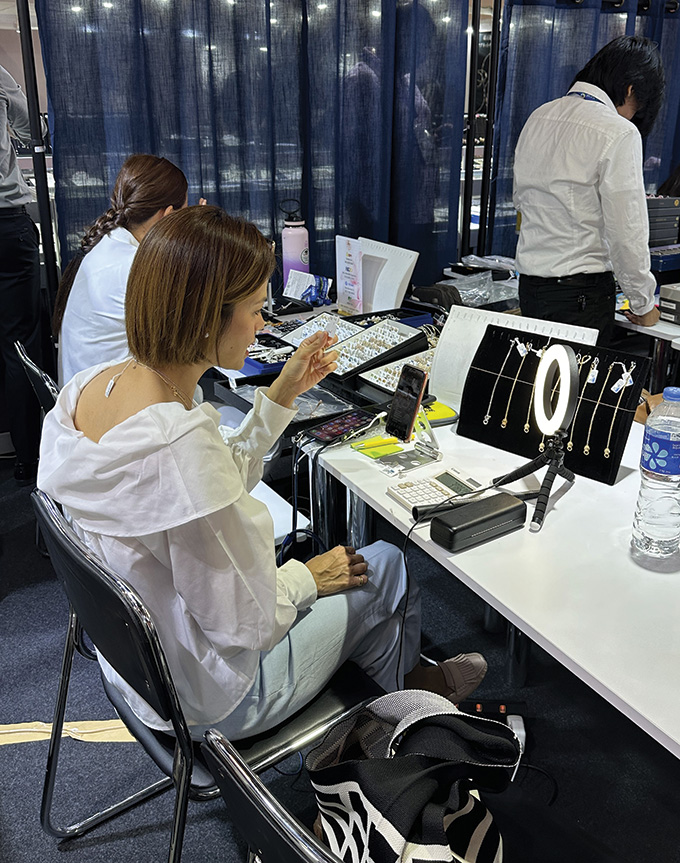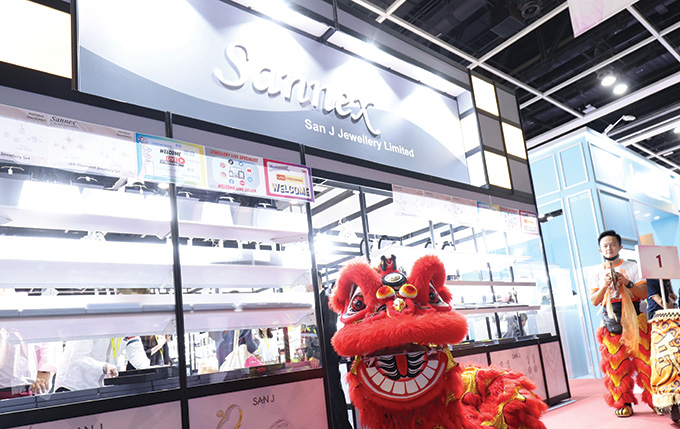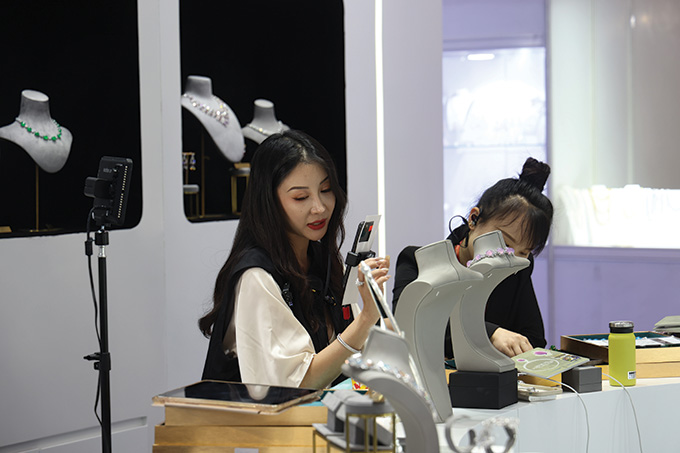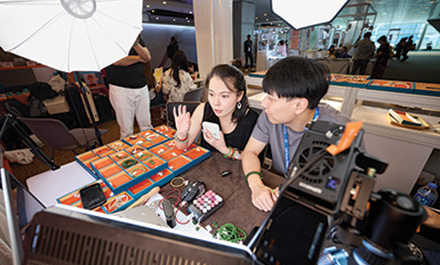Live selling continues to grow from strength to strength as a revenue stream for the jewellery trade, enabling manufacturers to increase sales while broadening their reach among today’s digitally savvy consumers.
This article first appeared in the JNA September/October 2024 issue.
Just a few years ago, the taking of pictures and videos was prohibited at most jewellery trade fairs. These days, the then-ubiquitous “No Pictures” card on display windows has been replaced in many instances by "Welcome Live" signs, signaling a marked change in the gem and jewellery industry as the trade increasingly embraces livestreaming as a new sales channel.
Live sellers once used to ply their craft at shows standing next to display counters, showcasing their latest finds to their followers on their mobile phones. Fast forward to 2024 and many jewellery companies allocate tables within their booths for live sellers, serving them tray upon tray of their products, which these buyers describe animatedly to their audience on tripod-held mobile devices backed by ring lights.
This shift in approach and acceptance of the live sales business model has its roots in the Covid years when consumers confined to their homes went online to make purchases. And this strategy, born largely out of necessity, has turned into a lucrative business opportunity for jewellery players big and small.
Channel evolution
KGK Group began exploring live selling and livestreaming as a sales channel during the pandemic, a time when the influencer business and live commerce market experienced significant growth globally.
According to KGK Group Vice Chairman Sanjay Kothari, this new sales channel allowed the company to adapt to changing consumer behaviours, where more people were shopping online and seeking interactive, real-time shopping experiences.
The live selling business of Vithal Trading pre-dated the pandemic. Before the Covid-19 outbreak, the jewellery manufacturer was already entertaining livestreamers in its office who would sell to their followers on WeChat and other Chinese social media platforms, according to Chetan Kumar Palriwala, director of Vithal Trading Co Ltd in Japan.
Many live sellers would also attend Vithal Trading’s monthly livestreaming events in its Japan office. When Covid lockdowns hit, the company tapped local live sellers, mostly Filipinos based in Japan.
Jewellery manufacturer Hatai Gems and Jewelry in Thailand also started working with live sellers during the Covid years. It now has a steady base of livestreamer buyers from Thailand, China and the Philippines, among others, who sell its products during trade shows or conduct live selling sessions at the company’s office, said Sales and Marketing Director Yanida Siamwalla.
Zhejiang Ming Huang Jewellery Co Ltd of China uses livestreaming for both sales and branding purposes. Company Chairman Zhou DingXiang said, “We leverage a multi-platform approach, engaging audiences on TikTok, Tmall and Red Book to amplify our brand presence. We promote responsible consumption practices and provide educational information to improve consumer understanding of jewellery.”
KGK also conducts its own live selling initiatives and collaborates with Key Opinion Leaders and live sellers across different markets. It has an internal screening process to select influencers and live sellers, evaluating them based on social media metrics, financial stability, and their ability to effectively engage with their audience, according to Kothari.
“This rigorous selection process ensures that KGK partners with credible and influential live sellers who can represent the brand and its products effectively,” he continued.
Global market
For these enterprises and many more of their kind, live selling opened the doors to new markets around the world, enabling them to engage directly with consumers.
Vithal Trading works with 200 live sellers from various parts of the world – China, the Philippines, Thailand and Vietnam, to name a few. Aside from live selling initiatives at trade fairs, it continues to hold monthly livestreaming events. The Hong Kong office deals primarily with Chinese live sellers while the Japan office works predominantly with Filipino livestreamers based in Japan.
“Filipinos are bilingual – sometimes, even multilingual – and travel frequently. They reach a wider audience; we get sales from Japanese housewives, consumers in Asia, the US and even Spain and the United Arab Emirates from our livestreams with Filipino sellers. Their language abilities enable them to tap an extremely international market,” explained Palriwala.
KGK’s Kothari agrees that the global reach of livestreaming sessions is a major draw. He said, “These platforms have a broad reach, allowing us to tap into various markets globally, all in one session. The real-time nature of live selling also allows for immediate feedback, enabling quick adjustments to product presentations and sales strategies.” For KGK, the live selling model works particularly well in the US, China, Hong Kong, Japan and other Asian countries. Aside from the convenience the channel affords, live selling offers a level of authenticity that resonates with buyers – real-time product demonstrations allow consumers to see the product’s features up close and ask questions directly, which builds trust. The sense of urgency and excitement generated during live sales also creates a feeling of exclusivity, which appeals to consumers who enjoy being part of a unique shopping event.
Effective conversions
Live selling has become a significant and growing portion of KGK’s overall sales, according to Kothari. Midrange to high-end jewellery tends to perform well during such sessions, particularly items that can be easily showcased and appreciated through video. These include intricate necklaces, rings and bracelets that feature unique designs or gemstones.
“The price points that resonate most with live selling audiences are generally those that offer perceived value, whether through the quality of the materials, the design or the exclusivity of the piece,” he revealed.
As it anticipates the live selling trend to grow further over the coming years, KGK intends to deepen its engagement with emerging influencers and expand its live selling initiatives into new markets.
The channel has also become a significant revenue stream for Vithal Trading. Palriwala estimated that half of the company’s sales now comes from live selling and the other half from its wholesale business.
“We do not consider live sellers as our agents. They work very hard to showcase our jewellery to their audience. They are our valued buyers and, in a way, our suppliers, providing us with a wide range of customers,” he said.
Growth potential
For Hatai Gems, livestreaming brings in over 10 per cent of sales and is poised to contribute even more, said Siamwalla. The live sellers it works with adopt two approaches – either selling existing stock or placing orders for more popular items, she disclosed.
“When we attend exhibitions in Thailand or overseas, our regular livestreamers would contact us to request for a space for their sessions. We reserve this for them and prepare the stock they would sell, based on their preferences. The live selling field is quite competitive too,” she continued.
Chinese pearl jewellery retailer Y&M Pearls started selling jewellery through livestreaming in 2022, according to Ye XiaoBo, chairman of Y&M Pearls. Sales have since maintained an upward trajectory, with 80 per cent of overall sales generated from livestreaming in 2024.
As the livestreaming sector is well established and highly competitive in China, businesses there are adopting new strategies to further boost sales.
“Livestreaming + short video” has proven an effective strategy to drive sales, according to the China Internet Network Information Center (CNNIC). Data from CNNIC’s Blue Book on Internet Empowered Digital Consumption Report released in June 2024 showed that 71.2 per cent of users who watch short videos or livestreams have made purchases.
Short-form videos on social media platforms now serve as pre-sale activities for livestreaming sessions. Companies use these to initially engage users with diverse content that resonates with the audience. This, in turn, encourages them to join the livestreaming sessions where they are prompted to make purchases.
Navigating challenges
The live selling model however comes with its own set of challenges. Companies often cite a high rate of returns from live sales, arising from consumer dissatisfaction with purchased items.
For Ye, these are understandable, given the high unit prices of jewellery. Consumers are naturally selective in their choices, particularly since jewellery is not a necessity. Refund and return options play a crucial role in safeguarding consumers’ rights during online purchases, she noted. “We can boost consumer confidence by producing good-quality products that meet their expectations and providing detailed explanations during the livestreaming sessions,” Ye said.
KGK has also observed some returns from live sales but mitigates this through detailed product descriptions and high-quality video demonstrations during live sessions. The group has managed to keep return rates at a manageable level by setting clear expectations and providing thorough product information, said Kothari.
Chinese jewellers also cite misleading information from merchants, the sale of counterfeit items and passing off lower-quality goods as premium items as major concerns in the live selling field.
Coordinating live sessions across different time zones can be logistically complex, and ensuring consistent quality in presentations across diverse markets and influencers requires careful management, Kothari said.
Despite these challenges, jewellers are in agreement that live selling is a dynamic and valuable channel with considerable potential for growth.




